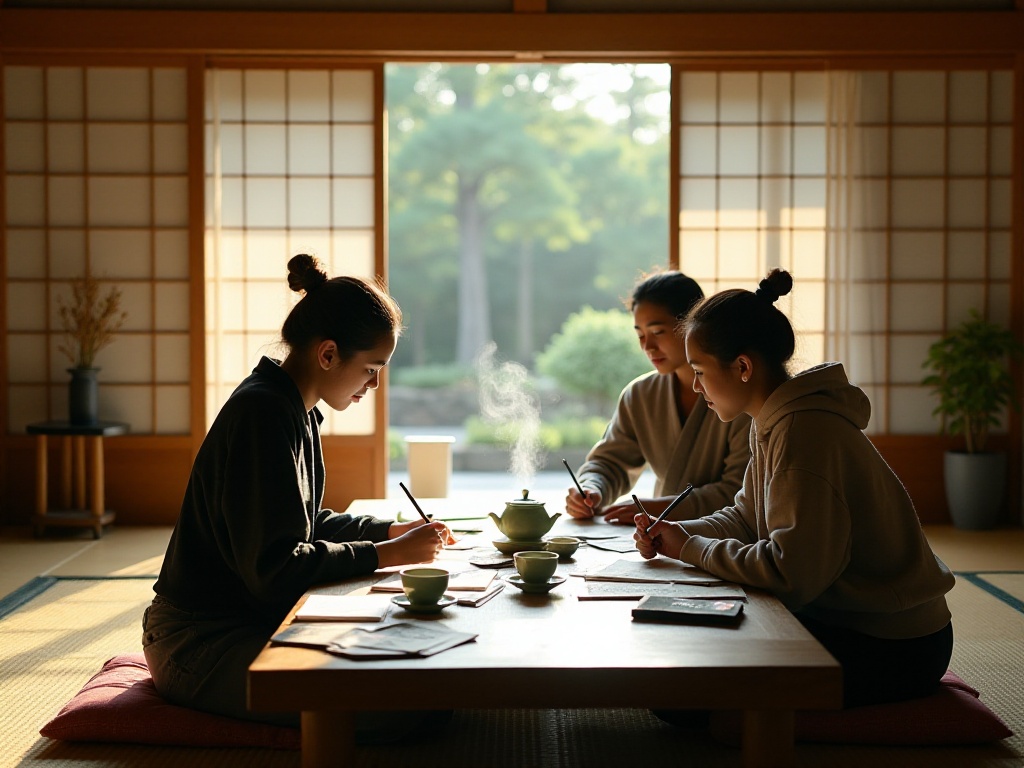
The Beginning
On that summer morning in 2023, I stood in the arrival hall of Narita Airport, watching the crowds coming and going, feeling both excited and nervous. My palms were sweaty as I gripped my suitcase handle, mentally rehearsing the three-month study abroad life that was about to begin. Although I had attended Japanese language training classes for over a year in China and passed N3, the prospect of actually living in Japan made this post-90s generation person, traveling abroad alone for the first time, a bit anxious.
I remember the night before departure, my mom specially made me a bowl of longevity noodles for good luck. Looking at the steaming noodles in the bowl, I felt a mix of emotions. This journey was not just about improving language skills, but also about challenging myself. Before leaving, I repeatedly checked my packing list: a "New Standard Japanese" textbook, a local housing rental guide, a Tokyo subway map, and several packets of Lao Gan Ma sauce that my parents had stuffed in my luggage. These personal items would witness my upcoming language learning journey.
Language Environment
During these three months in Tokyo, I truly experienced the magic of an immersive language environment. I remember my first week in Japan, staying in a small apartment in Shinjuku. Every morning at seven, the convenience store cashier would say "いらっしゃいませ" in her sweet voice. At first, I was too nervous to speak and could only nod and smile. Gradually, I started trying to respond with "おはようございます", and later, I could even chat with her about the weather.
Every scene in daily life became my Japanese classroom. The Japanese instructions on ticket machines at subway stations became the best learning materials; the amounts announced by cashiers at supermarkets became live listening practice; even the instructions at the laundromat became good tools for improving reading comprehension.
I remember once when buying oden at a convenience store, I accidentally said "おてん" instead of "おでん". The clerk gently corrected my pronunciation and explained it slowly. These subtle interactions helped me deeply understand Japanese people's rigorous attitude toward language. Every night back at my apartment, I would record new words and expressions learned that day in my notebook, and watching it grow thicker day by day gave me a sense of achievement.

Practical Living
Signs throughout Japan's streets and alleys were excellent learning materials. The electronic bulletin boards at Shibuya Station updated daily weather forecasts and railway information, and I often stopped to read and comprehend the content. The promotional posters in shop windows used vivid everyday language, teaching me many daily expressions. Words like "お買い得" (special offer) and "期間限定" (limited time) appeared frequently in daily life.
I set myself a small goal: record at least 5 new words or phrases encountered in daily life each day. These words came from real scenarios and were much more vivid than textbook examples. Supermarket food labels taught me to identify various ingredients in Japanese, while appliance store product manuals helped me master many technology-related vocabulary words.
There was a small library near my residence where I often borrowed children's picture books and manga. These materials used simple words and had interesting storylines, perfect for language learners. Gradually, I found myself understanding more and more content, and the joy of this progress was indescribable.
Once, when buying onigiri at a convenience store, I noticed the clerk had put on the wrong price tag. I explained the situation in Japanese, and although my grammar might not have been perfect, I successfully conveyed the message, and the clerk even thanked me. Such small incidents made me realize that the most important thing in language learning is daring to speak up and make mistakes.

Cultural Encounters
The homestay experience was the most valuable part of this study abroad program. My host family lived in a Japanese-style building in Tokyo's suburbs. Though the house wasn't large, Japanese living aesthetics could be felt everywhere. Grandpa and Grandma Tanaka were both retired teachers, and they treated me like their own grandson.
Every morning, Grandma Tanaka would prepare traditional Japanese breakfast: rice, miso soup, grilled fish, and pickled vegetables. During meals, we would converse in simple Japanese about topics like weather, food, and lifestyle habits. Grandpa Tanaka particularly emphasized etiquette, teaching me many situations for using Japanese honorific language. For example, saying "いってきます" when leaving and "ただいま" when returning home - these details reflected the politeness and respect in Japanese culture.
What touched me most was how they adjusted their conversation difficulty according to my Japanese level. At first, they used the most basic vocabulary and simple sentence patterns to communicate with me. As I improved, they gradually increased the complexity of expression. This progressive communication method unconsciously improved my Japanese level.
Every weekend, the Tanaka family would hold a "culture night." Sometimes we watched traditional Japanese films, sometimes we learned origami or calligraphy. Through these activities, I not only learned the language but also gained a deep understanding of various aspects of Japanese culture. Once, Grandma Tanaka taught me how to make sushi, teaching me ingredient names and preparation steps while we worked - this kind of practical learning was especially interesting and effective.

Social Circle
At the language school in Tokyo, I met international students from Korea, Thailand, America, France, and other countries. We all used Japanese as our common language, creating a unique linguistic environment. During breaks, we would exchange cultural characteristics from our respective countries and discuss topics of common interest in Japanese, such as anime, food, and travel.
Through Line groups, I joined several language exchange groups. Every weekend, we would hold tea parties at a café in Shibuya. I remember once we discussed education systems in our respective countries. Although everyone's Japanese level varied, we could all express our views using simple words. This cross-cultural communication not only improved oral skills but also broadened horizons.
I also met a group of friends who enjoyed watching Japanese dramas, and we often watched together, learning daily expressions and slang. Through watching dramas, I learned many colloquial expressions not taught in class. For example, youth expressions like "マジで" (really?) and "やばい" (terrible/amazing).
At language school, I participated in various cultural activities organized by the student council. Once, we visited a traditional wagashi-making workshop. The master demonstrated the process while explaining in dialect, and although I couldn't understand completely, this authentic language environment gave me a deeper understanding of Japanese language diversity.
Learning Methods
Regarding specific learning methods, my experience is to fully utilize fragmented time. While riding the subway each day, I would open the "Easy Japanese Learning" APP to review vocabulary and grammar. This APP's feature is gamifying learning content, making boring memorization interesting. "Duolingo" helped me systematically learn grammar structures, and completing each unit gave me a sense of achievement.
Besides APP learning, I particularly emphasized listening training. Every morning while getting ready, I would listen to NHK news. It was really difficult at first because the news broadcasts were fast and used many professional terms - I often couldn't understand a single sentence. But I told myself not to rush to understand every word, just try to catch keywords first. Two months later, I was delighted to find I could understand most of the content.
To improve oral expression, I often practiced pronunciation in front of mirrors, imitating the tone and intonation of drama characters. I also bought a pronunciation textbook and did oral muscle training every morning, practicing voiced and long sounds. Although it looked silly, it was really effective.
For writing, I insisted on keeping a diary in Japanese every day. At first, I could only write simple sentences like "今日は晴れです" (Today is sunny). As my vocabulary increased, I gradually became able to describe more complex things and feelings. My host grandmother would help correct my diary, pointing out grammar mistakes, and this timely feedback was very helpful for improving writing skills.
In-depth Experience
During my three months in Tokyo, I participated in many cultural experience activities. The most memorable was participating in tea ceremony courses. The tea ceremony teacher was an elegant lady wearing a kimono, who not only taught basic movements but also explained in detail the cultural meaning behind each step.
The word "一期一会" was learned in tea ceremony class. It emphasizes that each encounter is unique and we should cherish every moment. This gave me a new understanding of some profound concepts in Japanese. Language is not just a tool for communication but also a window to understand a nation's way of thinking.
I also participated in yukata experience courses. The teacher taught us how to properly wear yukata and tie the obi. During this process, I learned many professional terms related to kimono. When taking photos at Sensoji Temple wearing yukata, I felt the charm of traditional culture.
The most special was participating in a traditional woodworking course. The teacher was a woodcraft artisan who taught us to make simple wooden items. Although I couldn't understand many of the technical terms he used, through observation and imitation, I still successfully made a wooden coaster. This experience taught me that language learning sometimes needs to be combined with body language and practical operation.

Gains and Insights
Three months is neither long nor short. When I discovered I could casually chat with taxi drivers in Japanese and accurately order what I wanted at izakayas, I truly experienced what "learning by doing" means.
I remember when I first arrived in Japan, I had to repeatedly confirm prices at convenience stores, afraid of saying something wrong. Now I can easily complete daily conversations and even understand some Japanese jokes. This progress didn't happen suddenly but was the result of daily accumulation.
In the final exam at language school, my Japanese level improved from N3 to N2. But more important than test scores was gaining the ability to live independently in a foreign country. I learned how to open a bank account, how to mail packages at the post office, how to make doctor's appointments. These are all practical life skills.

Future Outlook
This study abroad experience in Japan made me deeply realize that the key to language learning is using it. No matter how much knowledge you have from textbooks, if you don't apply it in real life, it's just theoretical. The advantage of short-term study abroad is that it completely immerses you in the target language environment, forcing you to use the language.
My experience tells me not to be afraid of making mistakes or worried about imperfect grammar. The important thing is to dare to speak up and communicate. On Japan's streets and alleys, in conversations with strangers, in dealing with various daily matters, language ability improves unconsciously.
Now I'm back in China, but I still maintain the habit of learning Japanese. I regularly video chat with friends I met in Japan and continue watching Japanese dramas and news. This learning has become part of my life.
Life is made up of countless encounters. And language is the key that opens the doors to these encounters. It not only helps you make new friends and understand new cultures but also helps you discover a new self. If you're also learning a foreign language, try short-term study abroad. I believe you'll definitely gain your own wonderful story.
This experience taught me that language learning isn't a sprint but a marathon. What's important isn't speed but persistent perseverance. On this path, everyone can find their own rhythm and method. And the most beautiful scenery is often found in the process of persistence.
Next
Learning Languages in Foreign Lands: An Immersive Experience Shared by a Travel Blogger
Explore the dynamic relationship between travel and language learning, examining how immersion enhances language skills and how linguistic abilities deepen travel experiences through cultural engagement and authentic interactions
One Person's Language Journey: Measuring the World with Footsteps, Making Travel the Best Language Classroom
Explore effective methods and benefits of learning languages through travel, combining immersive strategies with practical approaches, supported by digital tools and structured resources for enhanced language acquisition and personal growth
One Person's Language Learning Journey: My 90-Day Immersion Experience in a Rural Japanese Town
Explore how travel facilitates language learning through immersive environments, covering natural and structured learning methods, along with guidance on choosing suitable language programs and courses to enhance language skills while traveling
Next

Learning Languages in Foreign Lands: An Immersive Experience Shared by a Travel Blogger
Explore the dynamic relationship between travel and language learning, examining how immersion enhances language skills and how linguistic abilities deepen travel experiences through cultural engagement and authentic interactions

One Person's Language Journey: Measuring the World with Footsteps, Making Travel the Best Language Classroom
Explore effective methods and benefits of learning languages through travel, combining immersive strategies with practical approaches, supported by digital tools and structured resources for enhanced language acquisition and personal growth

One Person's Language Learning Journey: My 90-Day Immersion Experience in a Rural Japanese Town
Explore how travel facilitates language learning through immersive environments, covering natural and structured learning methods, along with guidance on choosing suitable language programs and courses to enhance language skills while traveling



